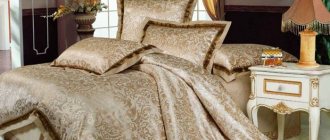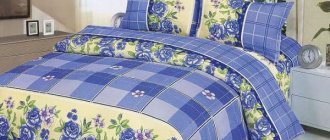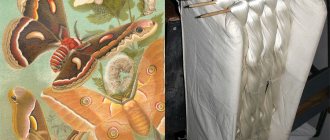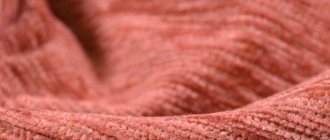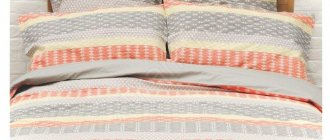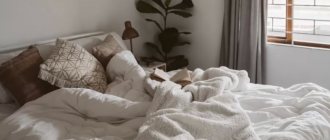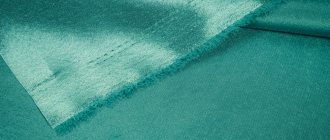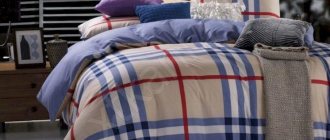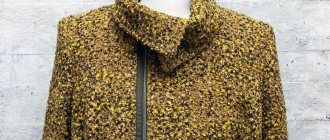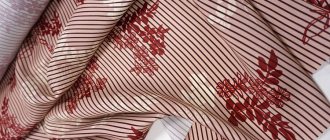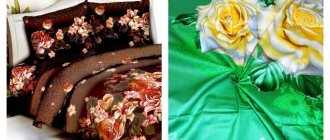Home / Products
Back
Published: 02/04/2021
Reading time: 3 min
3
139
Satin bed linen is a durable material made with traditional satin weaving. Thanks to this technology, the surface of the canvas is smooth and has a glossy shine. The reverse is rough with a small pile. Mainly used for sewing sleeping sets for children and adults.
- 1 General characteristics
- 2 Types of satin for bed linen
- 3 How to care for accessories
- 4 Criteria to determine quality when purchasing
- 5 Pros and cons of satin bed linen
- 6 Customer reviews about the kits
- 7 Conclusion
Satin - what kind of fabric is it?
Satin is a fabric made from twisted cotton fibers of satin (satin) weave. Characteristic features of the material are a shiny front and matte back side. This effect is achieved thanks to weaving, in which several warp threads overlap one weft thread.
The minimum number of warp threads in one repeat is 4 pcs. The stronger the fibers are twisted, the greater the shine intensity of the fabric.
Photo: What satin looks like, close up
Fabric structure
Cotton sateen is a natural fabric, containing exclusively cotton fibers (100% cotton). But it is also divided into subspecies:
- Classic or regular satin;
- Satin jacquard;
- Stripe satin;
- Mako-satin;
- Coupon satin.
However, there are several more subtypes of mixed satin, including:
- Polysatin and sateen-double, which contain artificial and natural fibers;
- Crepe-satin and silk-satin are combined fabrics in which cotton is combined with artificial or natural silk.
Twill-satin belongs to a separate category, differing from satin in the processing of threads and weaving. To create it, untwisted threads and twill weaving are used, which makes the fabric less dense. The fabric itself can be either cotton or blended.
Quality
The characteristics of satin bed linen vary depending on the quality of the raw materials and components that make up the fabric.
The highest ratings go to bedding sets made from natural varieties of satin - they combine beauty and wear resistance, softness and wrinkle resistance, pleasant tactile sensations and hypoallergenicity.
The addition of synthetic threads to the composition does not affect the appearance of the product, but it affects the breathability of the fabric, its hygroscopicity, and can cause the formation of pilling during operation and the accumulation of static electricity. In some cases, mixed materials may cause skin reactions.
Satin and its varieties belong to the category of high-quality bed linen. A wide range of bedding sets of different quality and price parameters allows you to choose the optimal solution for each consumer.
Description of satin fabric
Satin looks different from other types of fabrics. This is due to a special method of weaving threads. The main part of the material is dense, and the front part is characterized by smoothness and lightness. The reason for this is the use of thinner threads, which, when twisted, create shine in the fabric.
Satin is often confused with calico and poplin. If you look at the drawing more closely, the difference will become obvious. Calico is represented by a pattern in the form of ordinary crosses, while the pattern of satin material is created much more complex. Poplin is made with a particularly important condition, which is the use of threads of different thicknesses.
You might be interested in what is twill satin: description of the fabric and differences from satin
Sundress
Types of satin for bed linen
Not all varieties of satin are equally suitable for making bed linen. The most expensive and high-quality varieties of cotton sateen are:
- Coupon satin. The material is prepared individually for each set and each detail of the bedding set corresponds to a verified image size printed using the printing method.
- Mako-satin. The raw material used is selected Egyptian long-staple cotton, whose fibers are carefully combed and twisted. The linen made from it is soft, delicate, durable and smooth.
- Satin jacquard is unique in that the pattern on the material is created using the jacquard weaving method. The result is a double-sided fabric with an elegant pattern created by a combination of shiny and matte areas. The only difference between the sides is that on one side the pattern will be slightly convex, and on the other side it will be depressed.
- Stripe satin also has a double-sided pattern, but unlike jacquard floral motifs, it adheres to strict lines and consists of alternating shiny and matte stripes.
The most popular, due to the combination of high quality and affordable price, are the following types:
- Cotton satin. They are ideal for bedding, satisfying the physiological and aesthetic needs of consumers.
- Silk-satin is a material that contains natural silk along with cotton. The combination of different types of natural fibers creates an interesting effect: one side of the material is smooth, shiny and slippery, and the other is matte and non-slip.
The budget group includes bedding sets made from the following materials:
- Polysatin (novosatin) is a combination of cotton fibers and polyester.
- Crepe-satin - cotton fibers interspersed with artificial silk threads.
- Twill-satin - found both from natural raw materials and with the addition of synthetic fibers.
Most types of this material have found their application for sewing bed linen, with the exception of stretch options, which are more suitable for making clothes, and double satin, which is mainly used as a lining material.
What's best for a child
Before determining whether satin or calico is better for a bedding set for a child, you need to know the selection criteria. Children's bedding sets must have the following characteristics:
- environmental cleanliness;
- natural materials;
- breathability;
- high comfort;
- easy care.
Calico is considered a little harsh for delicate baby skin. With frequent washing, there is a high probability that linen made from such material will fade quickly. Satin is more suitable for children: the fabric straightens quickly, is smooth and soft to the touch, as it is very similar to silk. The fabric does not electrify and also retains its shape even after intensive washing.
Advantages and disadvantages
The list of positive and negative qualities of satin is directly dependent on its composition. Among the advantages of fabrics made from natural cotton:
- Hypoallergenic. During the production process, raw materials undergo only safe processing methods and the finished products do not pose a risk to people with sensitive skin.
- Hygroscopicity. Cotton perfectly absorbs and removes excess moisture, maintaining a comfortable feeling in both hot and cool rooms.
- Breathability. One of the most important qualities of linen is ensuring air circulation.
- Strength and durability. The canvas is highly dense, durable and can last about 4-6 years with intensive use.
- Low thermal conductivity, thanks to which the fabric warms in a cool room and keeps pleasantly cool in a hot room.
- Aesthetics. The satin weave fabric looks advantageous due to the shine of the front side. The density and smoothness of the material makes it beautiful both bleached and dyed.
- A wide selection of patterns when using the jacquard technique, colors and designs when painting smooth surfaces.
- Low creasing. With proper drying, you can do without ironing.
- Minimum shrinkage of no more than 5%.
- Low maintenance requirements. It washes well at temperatures up to 40 degrees, without requiring specialized washing products. For spinning, 600-800 revolutions are enough.
The only disadvantage of cotton satin is the cost, and this will only apply to its individual types, such as jacquard, stripe, coupon and mako-satin.{banner_serefs}{banner_ondes}
Fabrics made from a combination of cotton and natural silk have almost all the advantages of cotton sateen, with the exception of some points:
- high price;
- more slippery front side;
- increased demands on product care.
Mixed fabrics are more affordable for buyers, do not wrinkle, have an excellent appearance, are strong and durable, but have several disadvantages:
- become electrified;
- become covered with pellets;
- have a lower degree of breathability and moisture absorption;
- may cause skin reactions.
General benefits
Satin is a natural cotton fabric of varying density. It is made of dense threads on the back side, and thinner ones on the front side. The special twisting of the threads gives satin its characteristic shine.
Satin density – from 85 g/sq.m. – this is a fairly high indicator, which allows the material to retain its original appearance for a long time. Manufacturers assure that high-quality satin is ready to withstand at least 300 washing cycles.
Other advantages of satin include:
- hypoallergenic;
- high density and at the same time good ventilation;
- exquisite appearance;
- affordable cost;
- wealth of colors;
- color stability.
Customer Reviews
Customer opinions depend on their demands on bed linen and experience with use.
Consumers who use natural types of satin are satisfied with everything about this fabric, including the cost, since it is completely justified and meets the quality of the product.
Moreover, it is not necessary to buy a luxury set made of jacquard or coupon sateen to appreciate all the advantages of cotton sateen.
Those who bought bedding sets made from mixed fabrics with the addition of synthetics had divided opinions. Some are satisfied with the quality, while others note such issues as the appearance of pilling, electrification and increased sweating due to the fact that the fabric “breathes” less well.
general characteristics
Cotton raw materials are predominantly used in the creation of home textiles. To enhance the strength properties, there are combined models with the addition of silk and synthetic fibers. Mixed satin for bed linen is cheaper than its natural counterpart. However, the quality remains at a high level.
Visually, the fabric differs in several ways:
- high density. Does not show through;
- color saturation. The fabric can be dyed in any tone. Color is maintained throughout the entire period of operation;
- smooth surface with a specific shine. Pleasant to the touch.
Note! Satin is pleasant to the touch. The structure of the front side is tactilely reminiscent of silk.
How to choose high-quality satin bed linen
In order for a bedding set to provide comfort while you sleep, you need to protect yourself from counterfeits and low-quality products:
- Check the composition - the higher the percentage of cotton, the better. If it is not indicated at all, the information on the sewn-in tag does not match the information on the packaging, or if it contains more than 50% synthetics, then such a product should not be purchased.
- Evaluate the quality of tailoring - there should be no crooked stitches or protruding threads.
- Pay attention to the smell - it should not be sharp or unpleasant. This smell indicates the use of cheap and low-quality dyes.
- Feel and try to stretch the fabric - it should not be loose or stretch too much.
- Weigh several proposed sets in your hands for comparison - natural satin weighs about twice as much as synthetic satin.
What density of satin is best for bed linen?
There are certain requirements for the material to be suitable for sewing bedding sets, and one of them is the density of the fabric. Linear density is determined by the number of threads per square centimeter, and surface density is measured in g/m2.
For different types of satin, the linear density is different and 1 cm2 contains:
- up to 130 threads for classic cotton sateen;
- up to 170 threads for coupon;
- up to 220 threads for fabric made using jacquard technique;
- over 220 threads for mako satin.
These figures correspond to a surface weight of 120 g/m2 for regular cotton or sateen blends and up to 220 g/m2 for premium material.
Origin story
Satin came to Europe at the end of the 12th century from China, where expensive ceremonial clothing was made from it. The name of the fabric comes from the word “Zaytun”. This was the Arabic name for the Chinese harbor of Quanzhou, from where satin was exported.
Only the top of the European nobility could afford fabrics such as satin and silk. The material remained an expensive overseas commodity until 1850, when self-taught British chemist John Mercer came up with the technology and filed a patent for the production of satin. Since the beginning of the 20th century, satin has become available to everyone.
Silk
Fame and luxury: a detailed review of silk fabric
more details
Which bedding is better: satin, poplin or calico
Comparing the different types of fabrics used for sewing bed linen will help you make a choice when it comes to purchasing the next set of bedding.
Calico
consists of 100% cotton without impurities. To create the fabric, plain weaving is used from fairly thick, untwisted fibers. Calico, compared to satin and poplin, seems rougher to the touch and looks looser, but its strength characteristics are not inferior to and even superior to these materials.
And although calico does not look so advantageous due to its rough texture and matte surface, it fully meets the basic requirements for good bed linen, such as: hygroscopicity, breathability, low thermal conductivity, durability and hypoallergenicity.
Another significant advantage of calico is that it has the most affordable price among other cotton fabrics.
Poplin
thinner than satin. Despite the plain weave, like calico, the type of fabric is different, since the warp and weft threads are different in thickness, which creates a characteristic scar on the fabric. Similarly, satin can be completely natural or mixed. Despite the fact that the fabric seems thinner, its density is comparable to satin and ranges from 110 to 145 g/m2. Cotton poplin wrinkles very little, is almost not subject to shrinkage and can serve for a long time without loss of quality and external characteristics.
Poplin, which contains silk, is more difficult to care for and a little slippery, which is reminiscent of the qualities of satin. And the combination with synthetic fibers leads to problems for all mixed fabrics, such as: electrification, the appearance of pilling and deterioration of the breathable and moisture-wicking properties of the fabric.
There is no clear leader among the compared fabrics, since each has its own characteristics that can attract a particular consumer.
A person spends a significant part of his life sleeping and the better he can take care of comfortable rest, the more strength and energy he will receive in return. Smooth pillowcases, cozy duvet covers, soft sheets are important components that ensure healthy sleep. Satin bedding sets are deservedly among the bestsellers, as they have these and other properties of high-quality bed linen.
Fabric composition and properties
Originally, Chinese satin consisted of pure silk. Cotton sateen appeared after the invention of the mercerization process, and is now a common type of fabric. Elastane, viscose, and silk can be added to cotton.
Viscose
Synthetic viscose fabric: from an overview of the properties and types of material to rules for caring for things
more details
Elastane
Artificial elastane fabric: from production and properties to areas of use
more details
The properties of the material are determined by the composition and density, but are common to all types:
Durability and strength
Smoothness and shine
Low creasing
Comfort
Hypoallergenic
Hygiene (breathability + hygroscopicity)
